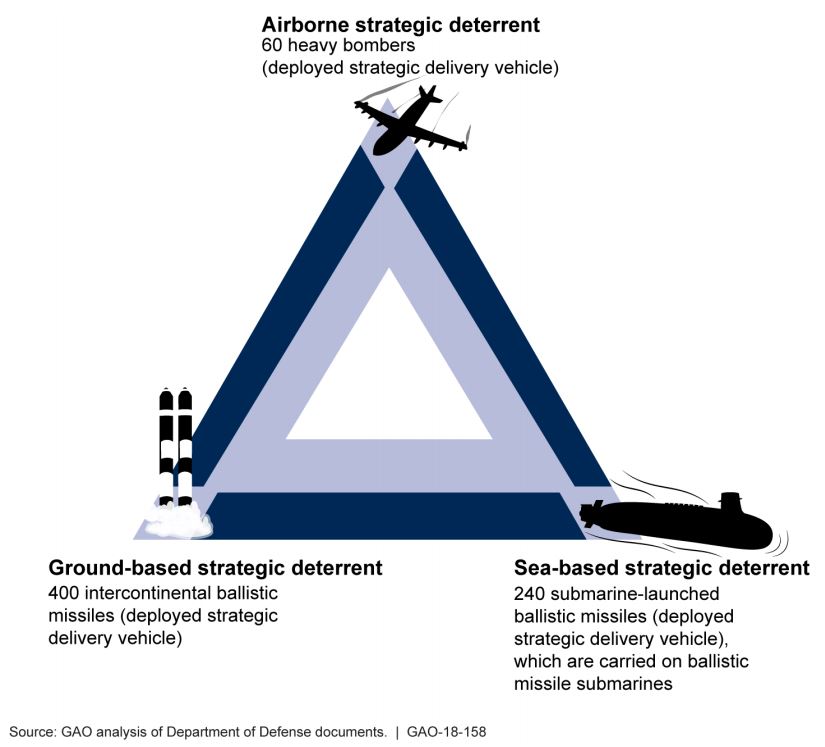SSBNs & the Nuclear Triad

Mission of SSBNs
The U.S. Navy operates three kinds of submarines—nuclear-powered attack submarines (SSNs), nuclear-powered cruise missile submarines (SSGNs), and nuclear-powered ballistic missile submarines (SSBNs). The SSNs and SSGNs are multi-mission ships that perform a variety of peacetime and wartime missions. They do not carry nuclear weapons.
The SSBNs, in contrast, perform a specialized mission of strategic nuclear deterrence. To perform this mission, SSBNs are armed with submarine-launched ballistic missiles (SLBMs), which are large, long-range missiles armed with multiple nuclear warheads. SSBNs launch their SLBMs from large-diameter vertical launch tubes located in the middle section of the boat. The SSBNs’ basic mission is to remain hidden at sea with their SLBMs, so as to deter a nuclear attack on the United States by another country by demonstrating to other countries that the United States has an assured second-strike capability, meaning a survivable system for carrying out a retaliatory nuclear attack.
Navy SSBNs, which are sometimes referred to informally as “boomers,” form one leg of the U.S. strategic nuclear deterrent force, or “triad,” which also includes land-based intercontinental ballistic missiles (ICBMs) and land-based long-range bombers. At any given moment, some of the Navy’s SSBNs are conducting nuclear deterrent patrols. The Navy’s report on its FY2011 30- year shipbuilding plan states: “These ships are the most survivable leg of the Nation’s strategic arsenal and provide the Nation’s only day-to-day assured nuclear response capability.” The Department of Defense’s (DOD’s) report on the 2010 Nuclear Posture Review (NPR), released on April 6, 2010, states that “strategic nuclear submarines (SSBNs) and the SLBMs they carry represent the most survivable leg of the U.S. nuclear Triad.”
The U.S. Strategic Nuclear Triad
The U.S. strategic nuclear deterrent is spread among three legs: Airborne, Ground-based, and Sea-based (as shown above).
This triad of strategic deterrent sources, is meant to ensure that the U.S. can always respond to any nuclear threat.
The Department of Defense (DOD) has continued to reinforce the high priority of the Columbia class
program to the nation’s long-term defense. SSBNs are designed to
maximize stealth to remain undetected while on patrol at sea. This
survivability gives the United States a credible ability to retaliate if faced
with an attack targeting other legs of the triad, and explains DOD's
decision to ultimately deploy up to 70 percent of the nation’s nuclear
warheads on SSBNs.
The DOD determined that ensuring a survivable U.S. deterrent requires continuous
at-sea deployments of SSBNs in both the Atlantic and Pacific oceans, as
well as the ability to surge additional submarines in crisis. Currently, 14
Ohio class SSBNs provide the sea-based strategic deterrent.
The Navy commissioned the lead ship of this fleet in 1981. The first Ohio class
SSBN to retire - SSN 730 - will leave service in 2027 and plans are to
retire one per year following this. When these submarines retire, they will
have been in service over 40 years, longer than any previous
submarines. Navy officials have stated that the legacy Ohio fleet cannot
be life-extended any longer than what is planned due to aging issues.
The U.S. Strategic Command (STRATCOM) retains operational control of
the strategic triad and determines how many SSBNs are needed to patrol
on a day-to-day basis. STRATCOM and the Navy have determined that
10 operationally available SSBNs are needed to meet mission
requirements. As a result, the lead Columbia class submarine must be
available for its first deterrent patrol in the first quarter of fiscal year 2031
to coincide with the planned 2031 retirement of SSN 734, or the Navy will
not have 10 operationally available SSBNs, thereby requiring DOD to
identify other steps to ensure it can meet current deterrent requirements.
Currently, it takes 14 Ohio class
submarines to provide 10 operationally available SSBNs due to
maintenance needs that can take up to 4 submarines out of the patrol
rotation at any given time. The Navy plans to reduce the number and
duration of required maintenance periods for the Columbia class, allowing
just 12 Columbia class submarines to provide the required 10 operational
submarines at all times. Between fiscal year 2031-2040, the Navy plans
to have a mix of 10 operationally available Columbia and Ohio class
submarines. In fiscal year 2041, with the retirement of the final Ohio class
submarine, this is to increase to 11 Columbia class, and finally to 12
operationally available Columbia class submarines by fiscal year 2042.
The Navy expects that it can meet mission requirements with 12
Columbia class submarines carrying 16 missile tubes (equating to a total
of 192 available tubes) in lieu of 14 Ohio class submarines carrying 24
tubes (336 total available tubes).
Columbia-Class Submarine Nuclear Firepower
Columbia-Class submarines will have sixteen (16) SLBM launch tubes, housed in four Common Missile Compartment (CMC) "Quad-Packs". Each SLBM launch tube could be armed with a Trident II D5 Missle. Each Trident D5 missle will carry eight (8) Thermonuclear MIRVs (Multiple Independently Targetable re-entry Vehicles), but could hold up to 12 MIRV Warheads. The total amount of MIRV Warheads on deployed SLBMs, deployed ICBMs, and deployed heavy bombers, is set at 1,515 by the New START Strategic Arms Reduction Treaty (March 2022). Note however, that in February 2023 Russia 'suspended its participation' in New START, while also stating it did not withdraw from the treaty and would continue to abide by the numerical limits set in the treaty.
It can be assumed, that each SSBN carries a potential 16 (missiles) * 8 (MIRVs each), equaling 128 W88 thermonuclear warheads. Each W88 has an estimated yield of 475 kt (kilotonnes) of TNT, which is enough firepower to potentially destroy any major city and most of the surrounding area in a 7-mile (11.2 km) radius. As STRATCOM requires a minimum of 10 deployed SSBNs, multiplied by 128 W88 MIRVs per sub, the sea-based U.S. strategic nuclear deterrent may potentially be 1,300 or more warheads.